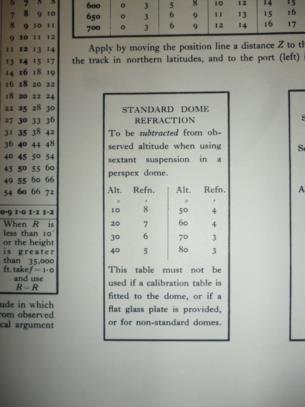
NavList:
A Community Devoted to the Preservation and Practice of Celestial Navigation and Other Methods of Traditional Wayfinding
From: David Pike
Date: 2014 Dec 4, 08:08 -0800
Gary, Greg
One problem you will get shooting astro from inside a blown or stretched Perspex canopy is refraction. Below is the table for a standard military astrodome. For an aircraft with a bubble type canopy such as the DHC Chipmunk or a Grob 115 you would get a similar effect although not quite so pronounced. Years ago, I spent a couple of weeks works experience at Slingsbys at Kirbymoorside when they were stretching hot Perspex glider canopies over a grease covered mould, so I know how the thickness changes. A 757 side window (below) with at least two layers to it would unlikely to be perfectly parallel either.
The acceleration errors on a bubble sextant might be random due to pilot error and turbulence, but you also have to consider the dynamic stability of the aircraft when considering the best length of shot. This is why RAF averaging sextants after the earliest MkIXs had a choice of one minute or two minute shots (BUT DON’T EVER TRY TO CHANGE GEAR WHEN ONE’S RUNNING!). A fore and aft shot is affected by the long period longitudinal oscillation or phugoid, which is a fairly long period change in height and speed at almost constant angle of attack. An athwart ships shot is affected by the other solution to the dynamic lateral/directional stability equations, the Dutch roll. If you sit back in an airliner and regard a spot on the wingtip against the horizon miles away, you’ll see the wingtip describing an ellipse against the horizon. That’s Dutch Roll. The period of the phugoid and Dutch roll depends upon aircraft mass speed and shape, so the length of shot matters. E.g. phugoid two minutes, shot one minute, average error isn’t necessarily zero. Dave








